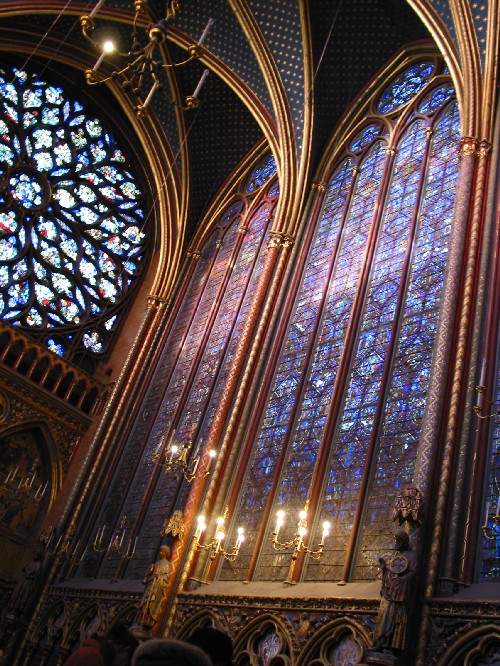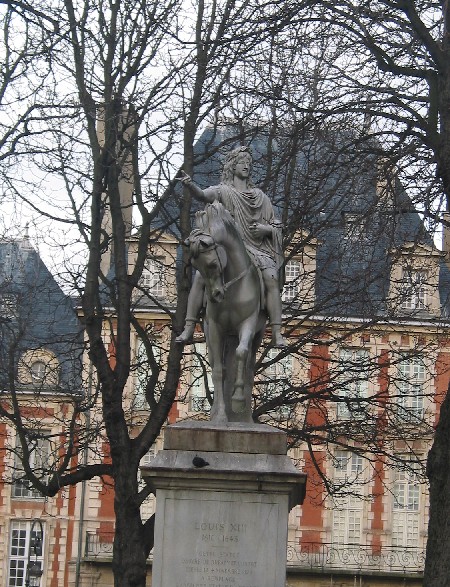Hôtel de Sully
62, rue Saint-Antoine. 4e arr.
Métro : Bastille (1, 5, 8)
During our ramblings through the Marais after using the Palm Pilot tour, we stumbled across the Hôtel de Sully, without knowing what it was. We entered through a doorway into a small courtyard surrounded by lavishly decorated buildings, with three carriage stalls on the right, one containing a small car. While we didn’t investigate further that day, we returned to the Marais many times during our two week stay, and we saw the  Hôtel de Sully two other times, with knowledgeable tour guides (Sophie and Jean-François) explaining about the building and its decorations.
Hôtel de Sully two other times, with knowledgeable tour guides (Sophie and Jean-François) explaining about the building and its decorations.
As with other hôtels particuliers, the houses of the French nobility, the buildings form a square around the courtyard, with the side facing the street known as the court side (housing the servants, kitchen, etc) and the side farthest away from the street known as the garden side, since the garden of the house is located on the other side of the building. The garden side houses the master and mistress of the house (on different floors), since that side has the view of the garden and is farthest away form the noisy, smelly street. The Hôtel de Sully was restored in 1965 and the building now houses the Caisse nationale des Monuments historiques in addition to a book store. The courtyard and garden are open to the public (the garden has a passage that leads to the Place des Vosges as well.
other side of the building. The garden side houses the master and mistress of the house (on different floors), since that side has the view of the garden and is farthest away form the noisy, smelly street. The Hôtel de Sully was restored in 1965 and the building now houses the Caisse nationale des Monuments historiques in addition to a book store. The courtyard and garden are open to the public (the garden has a passage that leads to the Place des Vosges as well.
Le Marais. 3e, 4e arr.  Métro : Hôtel-de-Ville (1, 11), Saint-Paul (1)
Métro : Hôtel-de-Ville (1, 11), Saint-Paul (1)
The Marais is one of the most historic sections of Paris, but it is also one of the most hip places to live. It is known for its museums, art galleries, synagogues, and gay bars, among other things. In order to get to know it better, we were provided with two Palm Pilots containing a pictorial tour of the Marais. The tour, called "Flaneurs Savants" created by Andrea McCarty and Rekha Murthy (two graduate students in Comparatiive Media Studies at MIT), started in front of the Hôtel de Ville and used pictures to guide us through the streets.The first landmark to get us started was the church with the red door (see picture). We continued down the street and saw, nestled between modern houses, two half-timbered houses, a style that dates back to the 15th century.  Although we abandoned the tour (it was too hard to look at it and the stuff around us at the same time), we did get to know the Marais on our many return trips.
Although we abandoned the tour (it was too hard to look at it and the stuff around us at the same time), we did get to know the Marais on our many return trips.
The Jewish section of the Marais was very evident by walking down the rue Pavée and seeing the oldest synagogue in Paris (and the traditional Jewish men in their suits, hats, beards and peyot (long sideburns). The whole area is filled with kosher restaurants and delis, like the one seen in the photo. The Marais is also known for its concentration of gay residents, due to the opening of many gay bars and clubs in the area. The proliferation of gay bars was a side effect of the commercialization of the area that led to the vast number of stores in the area. Gay or straight, the area does seem to inspire love, even in those too old to walk alone.


 Notre-Dame de Paris
Notre-Dame de Paris
6, place du Parvis-de-Notre-Dame. 4e arr.
Métro : Cité (4) or Saint-Michel Notre-Dame (4, B, C)
Located in the heart of Paris, on the Ile de la Cité, the famous cathedral Notre-Dame de Paris dates from the 12th century and is considered the most beautiful church in all of Paris. Even though the cathedral was built to last, its condition has deteriorated and it has been restored many times during its 800 years of existence. Victor Hugo’s novel Notre-Dame de Paris, the story of Quasimodo, brought attention to the need for the cathedral to be restored back in the early 19th century. While we were in Paris, part of the cathedral was also under construction. We saw Notre-Dame many times during our visit, since it was less than a 10 minute walk away from our hotel and since its height makes it visible from many other places in Paris, such as the top of the Centre Georges Pompidou.
 Inside the cathedral, the center of the building is filled with seats for people to attend mass, with a lavish altar near the back. Around the outside of these seats are the parts of the church designed for tourists. The beautiful stained glass windows are all visible, with confessionals and statues beneath. Small guide books on the cathedral in many different languages are available for purchase from machines near the entrance. If you want to light a candle for someone or something, there are many available to light, for a donation. Need a cross necklace? Check out the gift store inside the building. The cathedral truly is beautiful, but very commercialized.
Inside the cathedral, the center of the building is filled with seats for people to attend mass, with a lavish altar near the back. Around the outside of these seats are the parts of the church designed for tourists. The beautiful stained glass windows are all visible, with confessionals and statues beneath. Small guide books on the cathedral in many different languages are available for purchase from machines near the entrance. If you want to light a candle for someone or something, there are many available to light, for a donation. Need a cross necklace? Check out the gift store inside the building. The cathedral truly is beautiful, but very commercialized.
 |
 |
La Sainte-Chapelle
Boulevard du Palais. 4e arr.
In the 13th century, King Louis IX acquired a vast collection of holy relics from his journeys in the Holy Land. In 1248, to house his collection and to show his influence in the Christian world, Louis built the Sainte-Chapelle in the courtyard of his royal palace. For centuries it stood in the heart of Paris on Île de la Cite as both an important religious symbol and representation of the monarchy's power.
The Sainte-Chapelle is known now for its magnificent stained glass windows. The numerous panes in the chapel represent scenes and stories from the Bible, are interlaced with allusions to the French monarchy. Although the windows have been damaged several times, particularly in the fires of 1630 and 1776 and during the French Revolution, they underwent extensive restoration work in the 19th century and are close to their original state today. Remarkably, visitors can still see several original windows that have survived from the 13th century.(Source: www.monum. fr/m_stchapelle/)
The stained glass windows of the Sainte-Chapelle.
Place des Vosges
Adresse : place des Vosges. 4e arr.
Métro : Bastille (1, 5, 8)
 Right in the heart of the Marais is the place des Vosges and the square Louis XIII built in the beginning of the 17th century. Originally the square was called the Place Royale, but the name changed in the 19th century to honor the first French department to pay its taxes to the government. The square was conceived and designed entirely by Henri IV, from the two entrances to the 36 houses to each individual apartment. The apartments were rented out at reasonable rates, in exchange for which Henri IV asked that they not be altered in any way. The center of the square used to be completely open and was used for the inauguration of Louis XIII, hence the name of the current garden in the center. The square was envisioned as an open space for public gatherings. To this day, the place des Vosges is a place of housing around the outside and public gathering spot in the center.
Right in the heart of the Marais is the place des Vosges and the square Louis XIII built in the beginning of the 17th century. Originally the square was called the Place Royale, but the name changed in the 19th century to honor the first French department to pay its taxes to the government. The square was conceived and designed entirely by Henri IV, from the two entrances to the 36 houses to each individual apartment. The apartments were rented out at reasonable rates, in exchange for which Henri IV asked that they not be altered in any way. The center of the square used to be completely open and was used for the inauguration of Louis XIII, hence the name of the current garden in the center. The square was envisioned as an open space for public gatherings. To this day, the place des Vosges is a place of housing around the outside and public gathering spot in the center.
